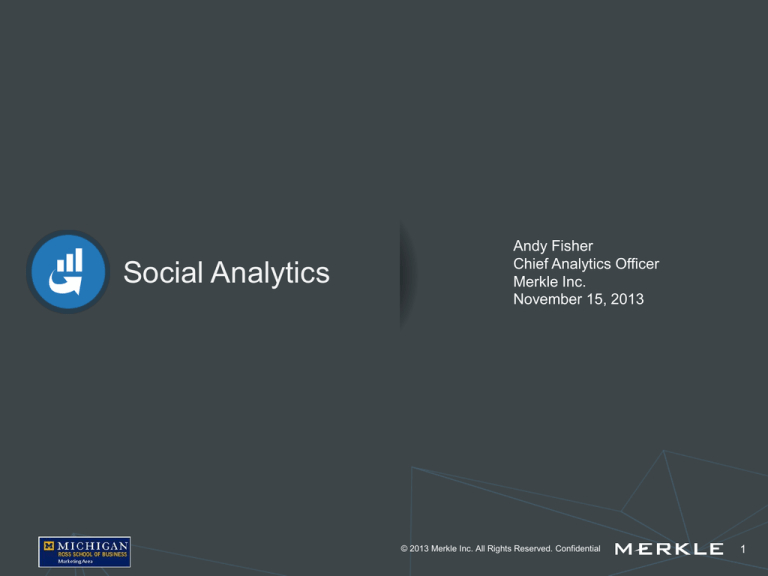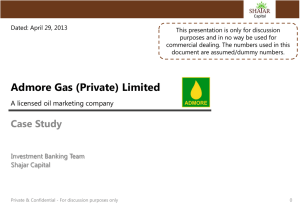
Social Analytics
Andy Fisher
Chief Analytics Officer
Merkle Inc.
November 15, 2013
© 2013
Merkle
Inc. All
Reserved.
Confidential
© 2013
Merkle
Inc.Rights
All Rights
Reserved.
Confidential.
1
Agenda
• About Merkle
• Social Definitions
• Media and Analytics History
• Social Integration Approaches
• Industry Examples
• Takeaways
© 2013 Merkle Inc. All Rights Reserved. Confidential.
2
Company Overview
Distinctive experience
Extraordinary expertise
• Privately held by current management since 1988
• 2,000+ Employees
• 150+ world class clients
• 250+ advanced degreed statisticians
• Manage over 140 marketing databases
• 300+ dedicated digital professionals
• Manage 1.6+ petabytes of customer data
• 650+ marketing technology professionals
• Inform over $10 billion marketing decisions annually
• 100+ creative professionals
Sustained 25% growth since 1989
$400
$365
Revenue in millions
$350
$303
$300
$255
$250
$211
$223
$180
$200
$150
$320
$148
Awarded and recognized
• Bronze Stevie Award “Business to Business Marketing
Campaign of the Year- Business Services” ‘13
• Ad Age A-List: “Agency to Watch in 2012”
• Largest privately-held agency in U.S., Ad Age ’12
• 6th Largest CRM/Direct Marketing Agency, Ad Age ’12
• Recognized by SmartCEO Magazine as a Future 50
Company ‘11
• NCDM Awards ’04, ’05, ’06, ’09, ’10, ‘11
$100
• Recognized by Forrester ’03, ‘06, ’07 &’10
$50
2006 2007 2008 2009 2010 2011 2012 2013E
• Multiple MAXI Award Winner ’10 ’11 ‘13
• Multiple DMA Innovation Award Winner ’10 ‘13
© 2013 Merkle Inc. All Rights Reserved. Confidential.
3
Our clients represent many of the best global brands
© 2013 Merkle Inc. All Rights Reserved. Confidential.
4
Definitions
Type
Definition
Example
Paid
Placements that and advertiser pays for on •Ads in FB newsfeeds
a social website
•Sponsored content on Twitter
Owned
Experiences where advertiser controls the
content
•Advertiser website
•Advertiser FB Page
Earned
Content about an advertiser where the
advertiser does not control the content
•Tweets from users
•Facebook likes
© 2013 Merkle Inc. All Rights Reserved. Confidential.
5
A brief history of Online Media
Audiences
aggregated by
content
1995-2005
Differentiation created
by Media Skills
Audiences
aggregates by
scaling niche
content
2005-2009
Differentiation Created
by Optimization
Audience
aggregated by
third party data
Audience
aggregated
using known
relationships
2009-2012
Differentiation Created
by Technology
2013+
Differentiation Created
by Data Integration and
Analytics
© 2013 Merkle Inc. All Rights Reserved. Confidential.
6
Reality Check
Sell side is far ahead of the buy side
Legal and operational infrastructure is problematic
To do this well you need
A new combination of skills
• Agency
• Programmatic expertise
• Classical planning expertise
• CRM
• First Party data management
Open Issues
Very new approach
• Legal
• Scale
• Business standards (T&C’s, makegoods, etc)
• Integration of Creative and Analytics
We believe this will become a major driver of value
Est. $8bn Totus spend by 2017
© 2013 Merkle Inc. All Rights Reserved. Confidential.
7
History of Marketing Mix Optimization and Attribution
MMO begins as
custom one-off
projects
Modern MMO
emerges
in CPG
Audiences
Industry
1940s-1970s
1980s
Low adoption,
lack of data, lack
of computing
power
aggregated
by content
Syndicated
scanner data
revolutionizes
industry
• Mainly academic
until 1970s
• Computing
problematic
• First MMO
product in 1979
• Regression
• MMO is panel
based, similar to
attribution today
• Panel
approaches fade
(will remain as
forecasting tools)
MMO scales
outside
CPG to
Audiences
include Auto,
aggregated
Finance and
by
content
Pharma
1990s
MMO (top down)
and Attribution
(bottom up)
unify
2000s
Computer power
increase (still
mainframes
though)
• MMO becomes
the standard
approach for CPG
• Models become
more complex
• First digital
models in 1999
Digital media
disrupts
MMO
Audiences
industry.
aggregated
Recovers by late
by
content
2000s
Mathematics of
digital need to be
created.
• Bayesian,
Markov, agentbased and other
models emerge
• First attribution
models in 2005
(based on 1979
panel models)
© 2013 Merkle Inc. All Rights Reserved. Confidential.
2010s
Mathematics of
paid digital fixed,
computation cost
falls to $0
• Focus on speed
and actionability
• Implementation
becomes limiting
factor
• Social become
the next frontier
8
Common Approach for Integrating Social
© 2013
Merkle
Inc. All
Reserved.
Confidential
© 2013
Merkle
Inc.Rights
All Rights
Reserved.
Confidential.
9
Step 1: Integrate Paid and Owned
Compile Data
Online
Email Activity (opens, clicks)
Web behavior (weblog)
Email subscription
User communities
Online registration
Coupon downloads
Digital media exposure
Social Behavior
Offline
POS Data
Coupon Redemption
Shopper Panel
FSP
In store promo
Objective
Function
Model the Data
and Iterate
Tie Engagement to
Revenue (Sample)
Brand X
1.5x
Brand Y
1.3x
Brand Z
2.3x
Evaluate
Individual level
Activity level
Segment Based
Determine Critical KPIs
Constant Evolution
Data drives what to measure
Segment level
© 2013 Merkle Inc. All Rights Reserved. Confidential.
10
Step 2: Build Attribution Models
Day 8-30
Day 1-7
Day 0-1
Transaction/
Conversion
Actual
experience
$
Direct or
Rules Based
(Basic)
0%
0%
$
100%
100%
Probabilistic
Model Based
(Advanced)
3%
14%
3%
0%
5%
5%
5%
15%
5%
Mass and Offline
Direct mail sent
TV view
5%
$
40%
Digital
Newspaper view
Display view
Website visit
Social visit
© 2013 Merkle Inc. All Rights Reserved. Confidential.
Paid search click
11
Step 3: X-channel modeling with Paid, Owned and Earned
TOP-DOWN MEDIA MIX MODEL (POS Data)
National media (TV & radio)
Local media (TV & radio)
Direct mail
Social
Digital
$140
$200
$180
$113
$83
calibration layer
BOTTOM-UP CONSUMER MODELING (Individual Response Data)
@
Display/ Video
Social
Paid Search
Email
$60
$113
$91
Direct mail
$80
$180
Campaign $
Network $
Engine $
Program $
Program $
Placement $
Program $
Branded $
Campaign $
Campaign $
Creative $
Campaign $
Keyword Segment $
Segment $
Offer $
Segment $
Campaign $
SEGMENT
BASED
ATTRIBUTION
Enlightened
Consumer
Time Savvy
Mom
Attribution needs to tie engagement to sales and
be customer centric by enabling segment-based
performance results of marketing
© 2013 Merkle Inc. All Rights Reserved. Confidential.
12
Reality Check
To do this well you need
MMO + Attribution
• Media Mix Optimization together with Attribution
• One model
• Integrates Offline and Online
• Most vendors doing some form of this
• Historically the two are related
Better Math
Attribution gaps
• Incrementality
• Decay Factors
• Interplay of media
• Math is understood
X-Channel experts
• Data Scientists
• All channel data
• Data Viz Experts
• Hard to find
Open Issues
Data Quality – Cooke Data has Issues
• Idea 1: Leverage CRM data
• Idea 2: Leverage Panels/”Good” samples
• Idea 3: Statistical Identification/Fingerprinting
• Idea 4: Model Cookie Deletion
• Idea 5: First Party Data
• No Silver bullet
Lack of Validation Social Challenges
• Rare in MMO
• Very rare in
Attribution
• No agreed upon
methodology
• Predicitvity
• Models
• Sentiment
Problems
© 2013 Merkle Inc. All Rights Reserved. Confidential.
13
Step 4: Deploy into optimization and personalization process
Creative selection
Increased Sales Force Prospecting
Decisioning
Digital
Media
For display, optimization
output is directly fed to
the Demand Side
Platform
For SEM, bidding engine
weights are output of
analytics correlating keyword
to high-value segments
Agent
Optimization
Feed
Sales force automation
/ call planning
prioritized by agent’s
segment and value mix
For site, real-time
integration of segments
into offer management
system
Search
Increased bid amount on
“retirement planning”
Site
Served Fixed Income X-sell offer
© 2013 Merkle Inc. All Rights Reserved. Confidential.
14
Reality Check
Many people doing within channel personalization well
Far fewer are doing x-Channel personalization
To do this well you need
Cross Channel Infrastructure
• Data source across channels
• Enterprise segmentation
• Cross channel Technology
• Within-channel activation
• The technology is good enough
Open Issues
Organizational Silos
• Different Goals
• Different notion of customer
• Lack of incentive
• Different measurement approaches
Think this will become a large practice moving forward
Big opportunity for people in the room
© 2013 Merkle Inc. All Rights Reserved. Confidential.
15
Industry Successes (and Otherwise…)
© 2013
Merkle
Inc. All
Reserved.
Confidential
© 2013
Merkle
Inc.Rights
All Rights
Reserved.
Confidential.
16
Tying social media initiatives to business outcomes
CHALLENGE
Company X
needed a way
to optimize
movie
promotion
dollars in an
environment
where every
dollar is spent
prior to the first
ticket sale.
APPROACH:
• Model buzz as the response variable to media
• Determine how buzz maps to box office sales
– Substantial historical database for modeling
– Bass-diffusion models simulate buzz build
– Incorporate HSX data
• Leverage buzz as campaign optimization tool
• Real-time forecasts of box office
• Learnings
–
–
–
–
Long dev process/custom
Treat as experimental
Required deep vertical knowledge
Success driven by lack of feasible plan B
© 2013 Merkle Inc. All Rights Reserved. Confidential.
17
Incorporating buzz metrics into media mix models
CHALLENGE
Coca-Cola
wanted to
leverage buzz to
improve their
MMO and
potentially
replace
expensive
brand tracking
surveys.
APPROACH:
• Incorporate buzz into MMO (input and output)
• Results: Buzz showed no correlation with sales
• Caveat 1: FB, Blogs, Twitter, YouTube only
• Caveat 2: Sentiment analysis challenges
• Next steps – refine approach and continue
• Learnings
– Long dev process/custom
– Treat as experimental
– Industry Backlash/PR issues
© 2013 Merkle Inc. All Rights Reserved. Confidential.
18
Getting past aggregate-level data
CHALLENGE
In order to
leverage social
data for CRM,
companies
must get to
segment-level
and even userlevel data which
isn’t available
from most
social media
platforms.
APPROACH
A technology retailer followed a four-step process to
build out a social data warehouse
that will connect to the CRM database.
1. Identify available social data assets and sources
2. Evaluate applicability of assets via three criteria:
•
•
•
Identifiable - does the data source help us connect to a
customer/prospect record
Actionable - can this data source be used to power more targeted
marketing – via email, social, or site content or analytics/insights
Scalable - how large is the population
of identifiable and actionable records
now and what is its expected growth
3. Prioritize social data assets based
on score and review privacy
implications
4. Define use cases to test CRM
program impact
© 2013 Merkle Inc. All Rights Reserved. Confidential.
19
Forecasting Tune-in
Challenge: Making Social Measurement Predictive
Example: Sharknado (SiFy)
Sharknado runs on SyFy
Major social media sensation
5000 tweets per MINUTE!
SyFy plans a rerun of Sharknado
SyFy green lights Sharknado 2
Twitter competition for tagline
Sharknado rerun airs and…
1.89 MM Viewers
Not too bad. But not great either.
Sharktopus = 2.5 MM Viewers
Average = 1.5MM Viewers
GoTH Red Wedding = 5.13MM
© 2013 Merkle Inc. All Rights Reserved. Confidential.
20
Takeaways
• Constantly Evolving Space
• Many problems and opportunities
• Trend towards first party data
• Pockets of measurement success
• Long way to go
• Social cannot be meaningfully measured in a silo
• Holistic approaches are necessary
• Lots of hype – and lots of content too!
© 2013 Merkle Inc. All Rights Reserved. Confidential.
21









